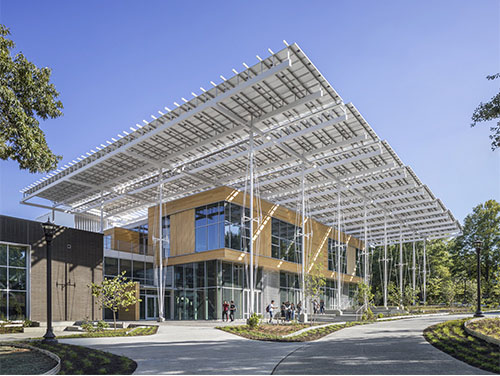
Kendeda Building in Atlanta, Georgia (Photo: Jonathan Hillyer)
Although architecture itself originated from a need for shelter from nature, modern humans retain the desire to live with nature around or near them—even in urban settings. Since the development of plate glass in the 17th century and mechanized heating and cooling in the late-19th and 20th, the relationship between architecture and nature has continually evolved to the point that architecture is now including or mimicking natural processes of decay and self-replication.
Over the course of the last century, the work of two architectural giants, Frank Lloyd Wright and Ludwig Mies van der Rohe, responded to nature in very different ways through their philosophies and approaches, influencing the work of other architects as well as builders and clients. Today’s architecture draws on the legacies of these groundbreakers, especially by integrating structures with the site, incorporating natural materials, or maximizing visual access to surrounding nature and the seasons.
Session Information
Beyond Sustainability: Living Architecture in the 21st Century
During the later decades of the 20th century, a growing environmental crisis coupled with emerging technologies inspired several architects worldwide to explore more eco-friendly architectures. Since then, a growing recognition that the eco-sciences and building technologies must work together has yielded many advances in sustainable, biomimetic, and regenerative building, guided in part by the LEED program (Leadership in Energy Leadership in Energy and Environmental Design) and more recently by the Living Building Challenge, administered by the International Living Future Institute.
Lindsay Baker, the institute’s CEO, discusses how 21st-century architects have addressed nature and the need to incorporate regenerative design and resilience in their work.
World Art History Certificate elective: Earn 1/2 credit*
About the Edith Farnsworth House
Designed and built between 1946 and 1951, the Edith Farnsworth House was as a weekend retreat for prominent Chicago nephrologist, musician, and poet, Dr. Edith Farnsworth, as a place to relax, entertain, and enjoy nature. It is recognized as an iconic masterpiece of the International Style of architecture and has National Historic Landmark status. The architect was Ludwig Mies van der Rohe, and this was his first and most significant domestic project in America. Located 58 miles southwest of Chicago, the glass and steel house is set within a natural landscape on a 62-acre parcel located along the Fox River. Learn more here.
Additional Sessions
General Information
*Enrolled participants in the World Art History Certificate Program receive 1/2 elective credit. Not yet enrolled? Learn about the program, its benefits, and how to register here.